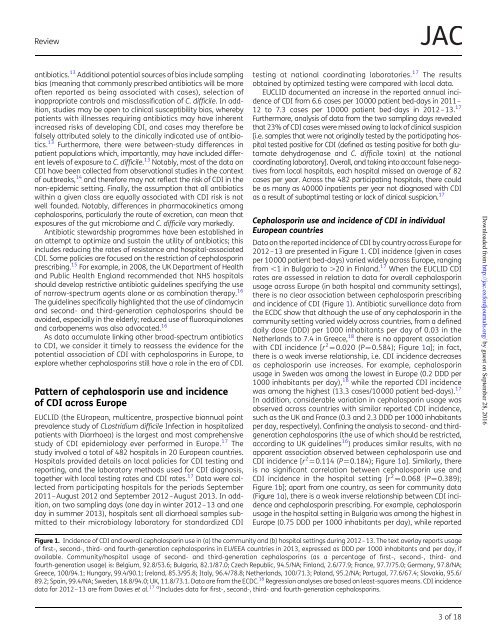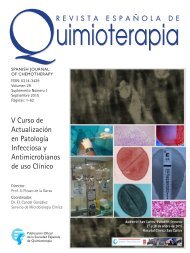http://jac.oxfordjournals.org/
jac.dkw385.full
jac.dkw385.full
Create successful ePaper yourself
Turn your PDF publications into a flip-book with our unique Google optimized e-Paper software.
Review<br />
JAC<br />
antibiotics. 13 Additional potential sources of bias include sampling<br />
bias (meaning that commonly prescribed antibiotics will be more<br />
often reported as being associated with cases), selection of<br />
inappropriate controls and misclassification of C. difficile. In addition,<br />
studies may be open to clinical susceptibility bias, whereby<br />
patients with illnesses requiring antibiotics may have inherent<br />
increased risks of developing CDI, and cases may therefore be<br />
falsely attributed solely to the clinically indicated use of antibiotics.<br />
13 Furthermore, there were between-study differences in<br />
patient populations which, importantly, may have included different<br />
levels of exposure to C. difficile. 13 Notably, most of the data on<br />
CDI have been collected from observational studies in the context<br />
of outbreaks, 14 and therefore may not reflect the risk of CDI in the<br />
non-epidemic setting. Finally, the assumption that all antibiotics<br />
within a given class are equally associated with CDI risk is not<br />
well founded. Notably, differences in pharmacokinetics among<br />
cephalosporins, particularly the route of excretion, can mean that<br />
exposures of the gut microbiome and C. difficile vary markedly.<br />
Antibiotic stewardship programmes have been established in<br />
an attempt to optimize and sustain the utility of antibiotics; this<br />
includes reducing the rates of resistance and hospital-associated<br />
CDI. Some policies are focused on the restriction of cephalosporin<br />
prescribing. 15 For example, in 2008, the UK Department of Health<br />
and Public Health England recommended that NHS hospitals<br />
should develop restrictive antibiotic guidelines specifying the use<br />
of narrow-spectrum agents alone or as combination therapy. 16<br />
The guidelines specifically highlighted that the use of clindamycin<br />
and second- and third-generation cephalosporins should be<br />
avoided, especially in the elderly; reduced use of fluoroquinolones<br />
and carbapenems was also advocated. 16<br />
As data accumulate linking other broad-spectrum antibiotics<br />
to CDI, we consider it timely to reassess the evidence for the<br />
potential association of CDI with cephalosporins in Europe, to<br />
explore whether cephalosporins still have a role in the era of CDI.<br />
Pattern of cephalosporin use and incidence<br />
of CDI across Europe<br />
EUCLID (the EUropean, multicentre, prospective biannual point<br />
prevalence study of CLostridium difficile Infection in hospitalized<br />
patients with Diarrhoea) is the largest and most comprehensive<br />
study of CDI epidemiology ever performed in Europe. 17 The<br />
study involved a total of 482 hospitals in 20 European countries.<br />
Hospitals provided details on local policies for CDI testing and<br />
reporting, and the laboratory methods used for CDI diagnosis,<br />
together with local testing rates and CDI rates. 17 Data were collected<br />
from participating hospitals for the periods September<br />
2011–August 2012 and September 2012–August 2013. In addition,<br />
on two sampling days (one day in winter 2012–13 and one<br />
day in summer 2013), hospitals sent all diarrhoeal samples submitted<br />
to their microbiology laboratory for standardized CDI<br />
testing at national coordinating laboratories. 17 The results<br />
obtained by optimized testing were compared with local data.<br />
EUCLID documented an increase in the reported annual incidence<br />
of CDI from 6.6 cases per 10000 patient bed-days in 2011–<br />
12 to 7.3 cases per 10000 patient bed-days in 2012–13. 17<br />
Furthermore, analysis of data from the two sampling days revealed<br />
that 23% of CDI cases were missed owing to lack of clinical suspicion<br />
[i.e. samples that were not originally tested by the participating hospital<br />
tested positive for CDI (defined as testing positive for both glutamate<br />
dehydrogenase and C. difficile toxin) at the national<br />
coordinating laboratory]. Overall, and taking into account false negatives<br />
from local hospitals, each hospital missed an average of 82<br />
cases per year. Across the 482 participating hospitals, there could<br />
be as many as 40000 inpatients per year not diagnosed with CDI<br />
as a result of suboptimal testing or lack of clinical suspicion. 17<br />
Cephalosporin use and incidence of CDI in individual<br />
European countries<br />
Data on the reported incidence of CDI by country across Europe for<br />
2012–13 are presented in Figure 1. CDI incidence (given in cases<br />
per 10000 patient bed-days) varied widely across Europe, ranging<br />
from ,1 inBulgariato.20 in Finland. 17 When the EUCLID CDI<br />
rates are assessed in relation to data for overall cephalosporin<br />
usage across Europe (in both hospital and community settings),<br />
there is no clear association between cephalosporin prescribing<br />
and incidence of CDI (Figure 1). Antibiotic surveillance data from<br />
the ECDC show that although the use of any cephalosporin in the<br />
community setting varied widely across countries, from a defined<br />
daily dose (DDD) per 1000 inhabitants per day of 0.03 in the<br />
Netherlands to 7.4 in Greece, 18 there is no apparent association<br />
with CDI incidence [r 2 ¼ 0.020 (P ¼ 0.584); Figure 1a]; in fact,<br />
there is a weak inverse relationship, i.e. CDI incidence decreases<br />
as cephalosporin use increases. For example, cephalosporin<br />
usage in Sweden was among the lowest in Europe (0.2 DDD per<br />
1000 inhabitants per day), 18 while the reported CDI incidence<br />
was among the highest (13.3 cases/10000 patient bed-days). 17<br />
In addition, considerable variation in cephalosporin usage was<br />
observed across countries with similar reported CDI incidence,<br />
such as the UK and France (0.3 and 2.3 DDD per 1000 inhabitants<br />
per day, respectively). Confining the analysis to second- and thirdgeneration<br />
cephalosporins (the use of which should be restricted,<br />
accordingtoUKguidelines 16 ) produces similar results, with no<br />
apparent association observed between cephalosporin use and<br />
CDI incidence [r 2 ¼0.114 (P¼0.184); Figure 1a]. Similarly, there<br />
is no significant correlation between cephalosporin use and<br />
CDI incidence in the hospital setting [r 2 ¼ 0.068 (P¼0.389);<br />
Figure 1b]; apart from one country, as seen for community data<br />
(Figure 1a), there is a weak inverse relationship between CDI incidence<br />
and cephalosporin prescribing. For example, cephalosporin<br />
usage in the hospital setting in Bulgaria was among the highest in<br />
Europe (0.75 DDD per 1000 inhabitants per day), while reported<br />
Downloaded from <strong>http</strong>://<strong>jac</strong>.<strong>oxfordjournals</strong>.<strong>org</strong>/ by guest on September 28, 2016<br />
Figure 1. Incidence of CDI and overall cephalosporin use in (a) the community and (b) hospital settings during 2012–13. The text overlay reports usage<br />
of first-, second-, third- and fourth-generation cephalosporins in EU/EEA countries in 2013, expressed as DDD per 1000 inhabitants and per day, if<br />
available. Community/hospital usage of second- and third-generation cephalosporins (as a percentage of first-, second-, third- and<br />
fourth-generation usage) is: Belgium, 92.8/53.6; Bulgaria, 82.1/87.0; Czech Republic, 94.5/NA; Finland, 2.6/77.9; France, 97.7/75.0; Germany, 97.8/NA;<br />
Greece, 100/94.1; Hungary, 99.4/90.1; Ireland, 85.3/95.8; Italy, 96.4/78.8; Netherlands, 100/71.3; Poland, 95.2/NA; Portugal, 77.6/67.4; Slovakia, 95.6/<br />
89.2; Spain, 99.4/NA; Sweden, 18.8/94.0; UK, 11.8/73.1. Data are from the ECDC. 18 Regression analyses are based on least-squares means. CDI incidence<br />
data for 2012–13 are from Davies et al. 17 a Includes data for first-, second-, third- and fourth-generation cephalosporins.<br />
3of18




